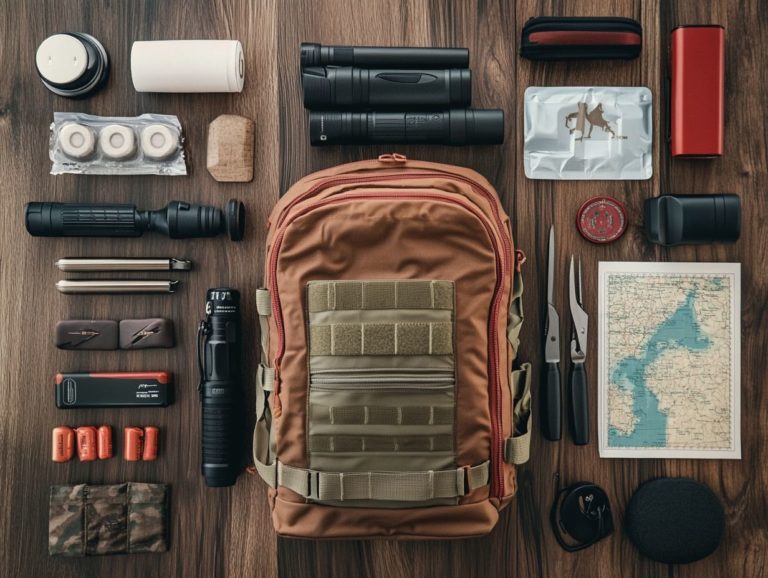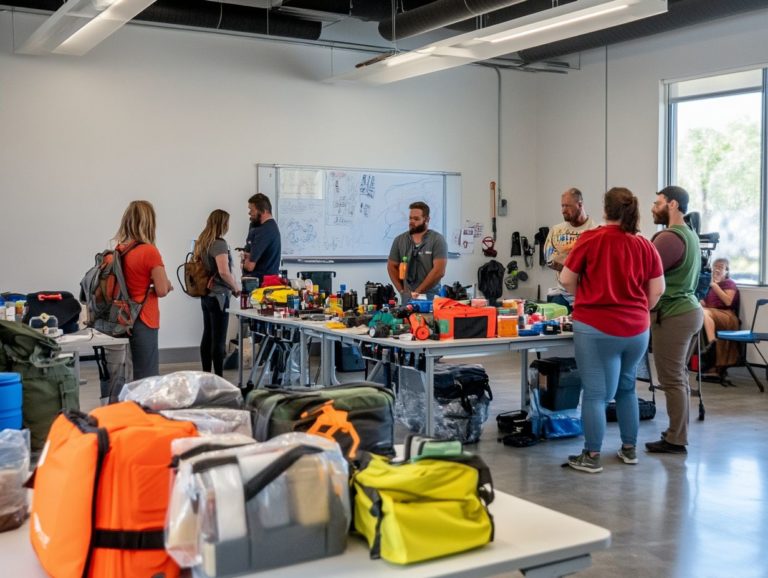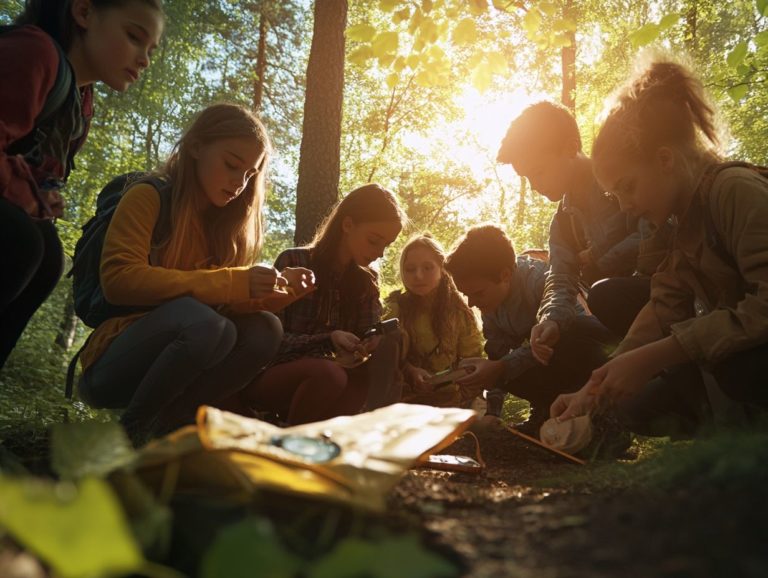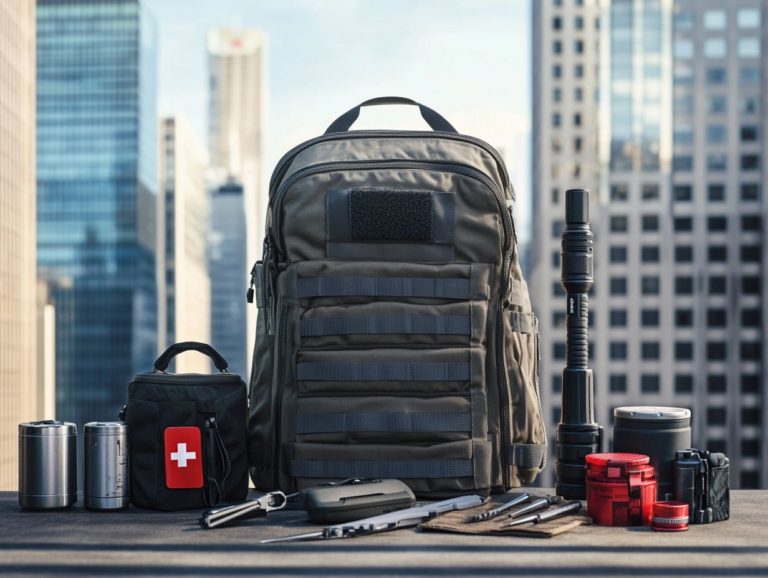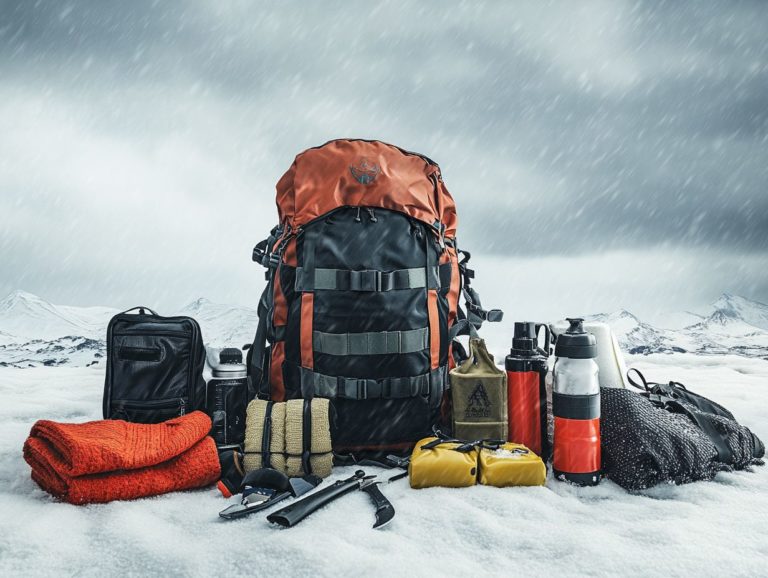Essential First Aid Items for Your Survival Kit
When it comes to safeguarding yourself and your loved ones, having a well-stocked emergency kit is absolutely essential for your preparedness for any situation.
Whether you re at home, traveling, or venturing outdoors, being prepared for minor injuries and health emergencies can truly make a world of difference.
This guide will help you navigate the must-have items for your survival kit. It covers everything from basic supplies like bandages and antiseptics to crucial tools such as a CPR (Cardiopulmonary Resuscitation) mask, emergency contacts, and personal medications.
Get ready to tackle any situation confidently!
Contents
- Key Takeaways:
- 1. A First Aid Kit
- 2. Bandages and Gauze
- 3. Antiseptic Wipes or Solution
- 4. Adhesive Tape
- 5. Scissors and Tweezers
- 6. Pain Relievers
- 7. Antibiotic Ointment
- 8. Hydrocortisone Cream
- 9. Burn Gel or Cream
- 10. Instant Cold Compress
- 11. Thermometer
- 12. CPR Mask
- 13. Emergency Blanket
- 14. Medical Information Card
- 15. Emergency Contact Information
- Frequently Asked Questions
- What are the essential first aid items that should be included in a survival kit?
- Why is it important to have first aid items in a survival kit?
- Can I add additional first aid items to my survival kit?
- How often should I check and replace first aid items in my survival kit?
- Are there special considerations when choosing first aid items for a survival kit?
- Can I use my survival kit’s first aid items for everyday use?
Key Takeaways:
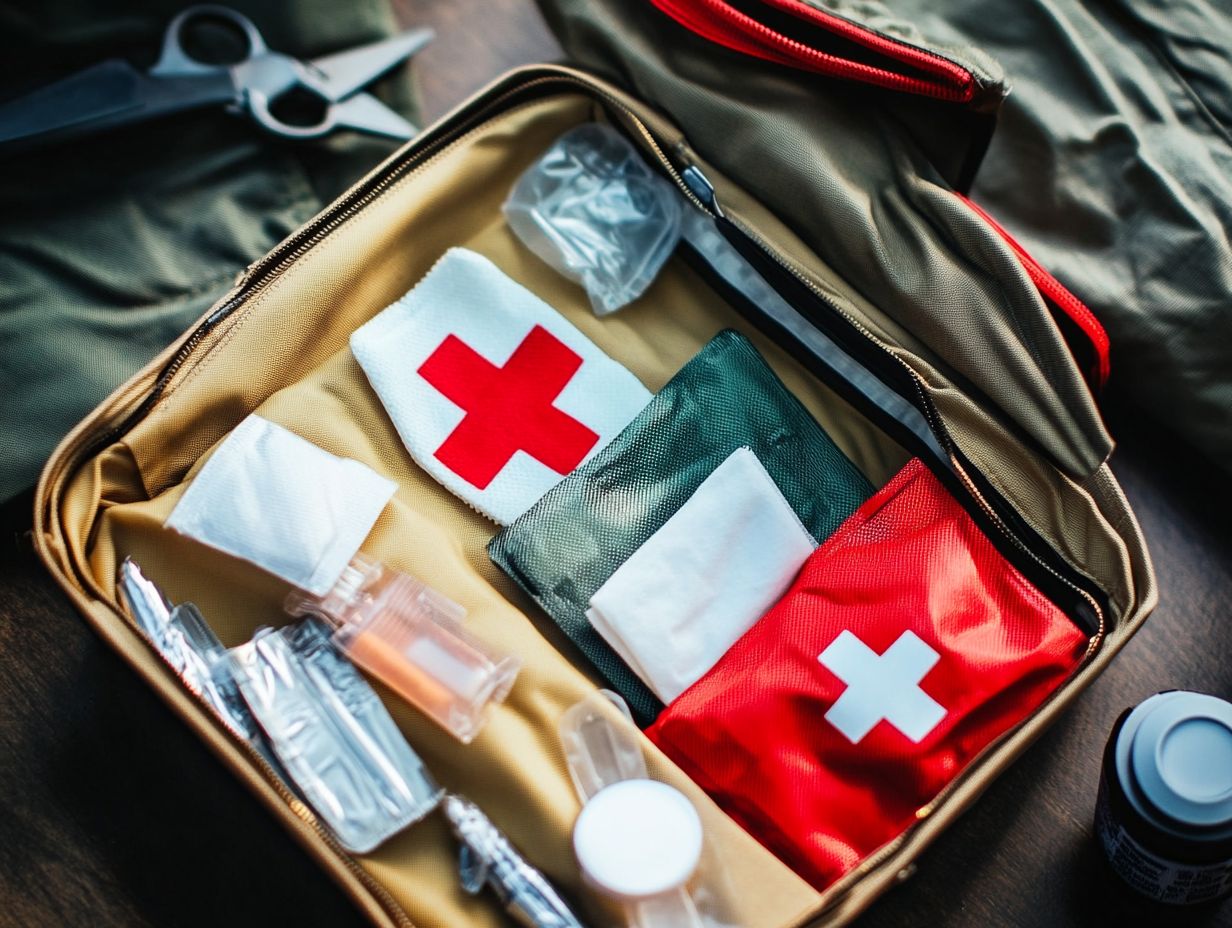
- A well-stocked first aid kit is essential for any survival kit, providing immediate care for injuries and illnesses in emergency situations.
- Bandages and gauze are important for covering wounds and stopping bleeding, while antiseptic wipes or solution can prevent infections.
- Other important items include pain relievers like acetaminophen and ibuprofen, antibiotic ointment, burn gel or cream, and a CPR mask, along with emergency contact and medical information.
1. A First Aid Kit
A first-aid kit is an important part of your emergency supplies, crafted to meet various healthcare needs and ensure you re equipped to tackle medical emergencies at home, in the workplace, or outdoors.
Whether you’re assembling a tailored kit for your family or preparing for outdoor adventures, it’s essential to include a diverse array of first-aid supplies that can effectively address common injuries.
In a well-stocked kit, you should include:
- Adhesive bandages in various sizes to cover minor cuts and scrapes.
- Antiseptic wipes or solution for cleaning wounds and preventing infection.
- Pain relievers such as acetaminophen or ibuprofen to ease discomfort.
- Instant cold packs for reducing swelling from injuries.
Keep a list of emergency phone numbers and medical history forms close at hand. This information can be invaluable for healthcare professionals in urgent situations, ensuring you receive appropriate care without delay.
2. Bandages and Gauze
Bandages and gauze are critical components of any first-aid kit, serving a vital purpose in controlling bleeding and shielding wounds from infection.
It s crucial to understand the different types available, such as adhesive bandages, gauze pads, and elastic bandages, to use them effectively. Adhesive bandages are perfect for minor cuts and scrapes, offering a breathable cover that keeps the wound clean. Gauze pads excel with larger wounds, providing absorbency when paired with medical tape. Elastic bandages are your go-to for sprains, delivering compression to help reduce swelling.
By having an assortment of sizes and styles at your disposal, you ll be well-equipped to address various injuries promptly, promoting quicker healing and minimizing complications. Knowing how to apply each type correctly can make a significant difference in the outcome.
Start assembling your emergency kit today!
3. Antiseptic Wipes or Solution
Antiseptic wipes or solutions are critical first-aid essentials for effective wound care. They are crucial for cleaning wounds, preventing infections, and ensuring optimal care during health emergencies.
These products come in various forms think alcohol-based solutions, iodine tinctures, and hydrogen peroxide. They are crafted to reduce microbial growth effectively. Alcohol-based wipes are particularly appealing due to their quick-drying properties and broad-spectrum efficacy. Iodine solutions offer impressive long-lasting antimicrobial benefits.
Mastering first-aid practices is your path to being a hero in emergencies! When you reach for those antiseptic wipes, make sure to clean the affected area thoroughly before applying them. Always allow the antiseptic to dry completely to maximize its effectiveness. Pair them with sterile dressings and gauze pads, and monitor the wound for any signs of infection in the days that follow treatment.
4. Adhesive Tape
Adhesive tape is essential in your first-aid kit, playing a crucial role in securing dressings and gauze. This ensures effective treatment for various injuries.
Understanding the different types of adhesive tape can elevate your first-aid game. For example, fabric tape stands out for its flexibility and durability, making it the go-to choice for securing larger dressings on joints. In contrast, hydrocolloid tape is a special tape that keeps wounds moist, making it ideal for treating minor burns or blisters.
When applying any adhesive tape, it s vital to cleanse the skin thoroughly to reduce the risk of infection and irritation. When it s time to remove the tape, do so gently. Always pull parallel to the skin and consider using warm water if needed. This approach minimizes discomfort and protects the delicate healing skin underneath.
5. Scissors and Tweezers
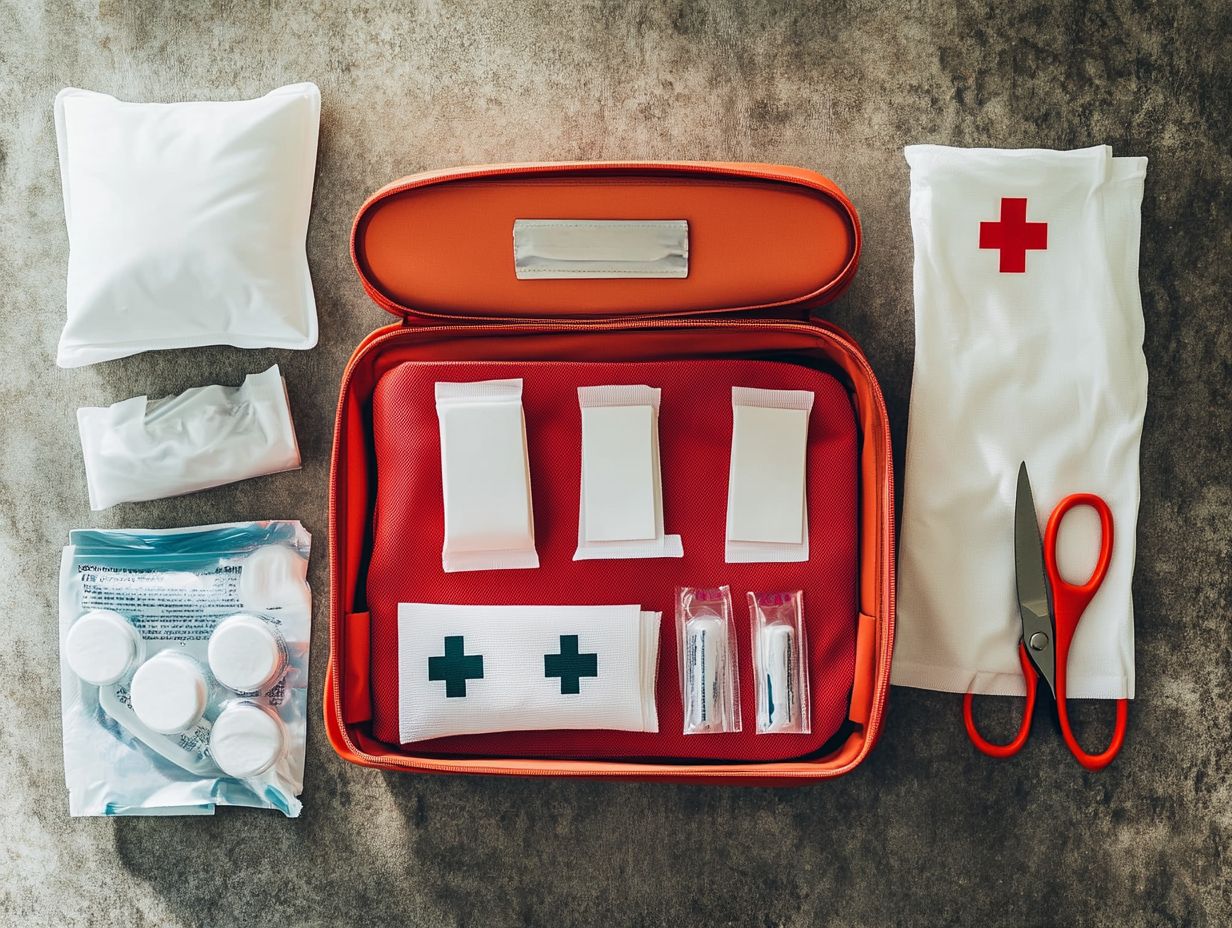
Keep a reliable pair of trauma shears and scissors handy. These tools are crucial for managing various medical emergencies, whether it s cutting tape or gauze or removing splinters and debris.
For tough materials, trauma shears are your go-to. They re designed to slice through difficult layers, making them invaluable when quick access to a wound is critical. Their angled design allows for safe cutting, minimizing any risk of injury to the patient.
Tweezers are critical for addressing minor wounds. Their precision enables you to deftly extract foreign objects or splinters that could lead to infections.
Maintaining hygiene with these tools is paramount. Ensure they are cleaned properly after each use to prevent cross-contamination and foster safer healthcare outcomes. Keeping them in good condition boosts your efficiency and enhances overall safety during crucial emergency moments.
6. Pain Relievers
Pain relievers, like aspirin packets, are critical components of your first-aid kit, offering swift relief for pain and discomfort in emergencies.
Include ibuprofen and acetaminophen, each offering distinct advantages. For example, ibuprofen excels at tackling inflammation-related pain, whereas acetaminophen is easier on the stomach.
When choosing these medications, consider your personal health conditions and any ongoing medications, as some individuals may experience contraindications with certain pain relievers.
Ensure your first-aid kit aligns with health insurance guidelines for medications. This can save you from potential headaches later on, as different insurers might impose restrictions or provide recommendations regarding over-the-counter pain medications.
By taking the time to carefully curate a well-rounded selection, you ll be ready for whatever situations may arise. Stock your first-aid kit now to ensure you re prepared for any emergency!
7. Antibiotic Ointment
Antibiotic ointment is an essential addition to your first-aid supplies, acting as a powerful ally in the battle against infections in minor cuts and scrapes. It ensures that you are well-equipped for health emergencies.
This cream or ointment applied to the skin works wonders by slowing down bacteria from growing, effectively protecting your wound from potential complications. To get the most out of it, remember to apply a thin layer directly to the cleansed area, ensuring you cover the entire affected surface. Wash your hands well before and after applying the ointment. This helps prevent infections.
By including antibiotic ointment in your first-aid kit, you’re not just enhancing your readiness for unexpected injuries; you’re also embracing a comprehensive approach to wound management. This proactive measure allows for quicker healing and significantly reduces the risk of infection.
8. Hydrocortisone Cream
Hydrocortisone cream is an invaluable first-aid essential, perfect for addressing various healthcare needs in those unexpected moments.
This topical medication shines especially bright for anyone dealing with allergic reactions, insect bites, or localized skin issues, providing quick relief from discomfort. It works by reducing inflammation and suppressing the immune response in the affected area, paving the way for a faster recovery. Just remember to apply it sparingly and for limited periods; overuse can lead to skin thinning or other complications.
If your symptoms linger beyond a few days or take a turn for the worse, it s wise to consult a healthcare professional. Persistent reactions may require alternative treatments or a more thorough evaluation.
9. Burn Gel or Cream
Burn gel or cream is a must-have in your first-aid kit, offering immediate relief from burns while promoting healing for burns that may occur in various emergency situations. Every second counts when treating burns, so keep your kit ready!
You can find these treatments in various forms, including water-based gels, silicone creams, and ointments enriched with calming ingredients like aloe vera. Each type serves a specific purpose whether it s cooling the burn, reducing inflammation, or keeping the area moisturized.
Application is key; gently clean the affected skin before applying a thin layer of your chosen gel or cream. By practicing timely and appropriate burn care, you can significantly reduce the risk of complications, such as infection or extended healing times, paving the way for a smoother recovery process.
10. Instant Cold Compress
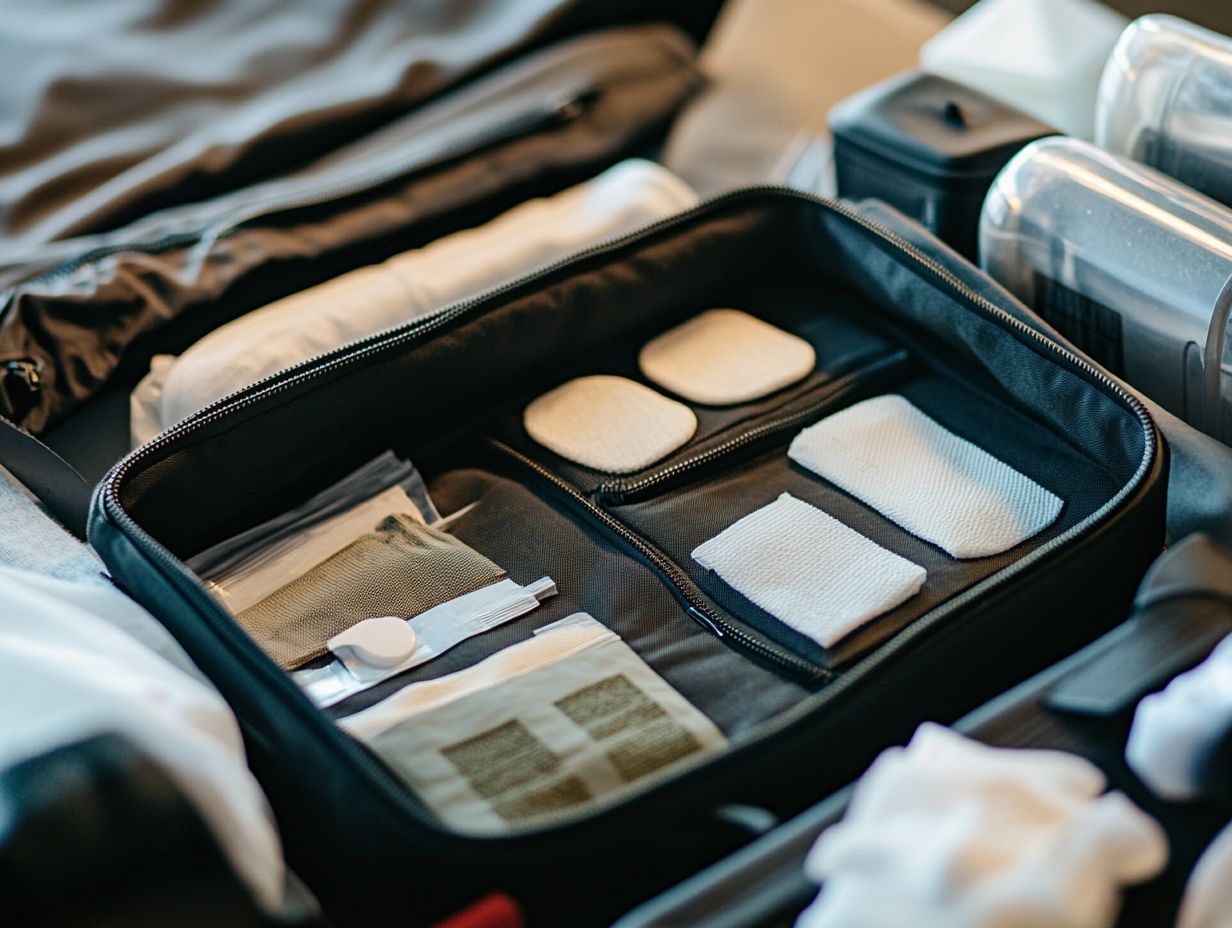
An instant cold compress is an essential asset for your first-aid kit, delivering immediate relief for swelling and pain when emergencies and injuries strike.
Its user-friendly design ensures that anyone can easily grab it, whether they re at home or out and about, offering crucial support in a variety of situations. For example, spraining an ankle while playing sports can dramatically reduce swelling and numb the area, easing that intense discomfort. Similarly, after a fall that leaves you with bruising, this straightforward tool can help minimize discoloration and accelerate your recovery.
Mastering the proper application of this compress not only aids in managing acute injuries but also promotes faster healing, ultimately enhancing the effectiveness of your first aid responses.
11. Thermometer
A thermometer is an essential component of your first-aid kit, crucial for monitoring body temperature during health emergencies and assessing the severity of an illness.
With an array of types tailored for different situations digital, infrared, and mercury thermometers each type offers specific advantages that can greatly influence timely medical decisions.
For instance, digital thermometers provide quick and accurate readings while being user-friendly, making them perfect for home use. Infrared options allow you to measure temperature without direct contact, which is especially beneficial for babies or in fast-paced environments.
Mastering the use of these thermometers gives you the power to determine whether immediate medical attention is necessary, highlighting the vital role temperature monitoring plays in urgent health scenarios.
12. CPR Mask
A CPR mask is an essential first-aid tool that allows you to deliver safe and effective rescue breaths during CPR, a lifesaving technique in emergencies. Having this equipment ready can greatly increase someone’s chances of survival during cardiac arrest.
When you perform CPR, it’s crucial to create a proper seal with the mask to ensure the air reaches the lungs effectively. Beyond just owning a CPR mask, enrolling in CPR training courses can immensely enhance your confidence and skills in handling emergencies. These courses teach you the correct techniques and protocols. They empower you to respond effectively in high-pressure situations.
13. Emergency Blanket
An emergency blanket is an essential component of your first-aid kit, crafted to provide warmth and protection against hypothermia, a dangerous drop in body temperature, in critical situations.
These lightweight, reflective sheets become invaluable not only during medical emergencies but also important for outdoor activities. Whether you re hiking through the mountains, camping under a starlit sky, or braving the unpredictable weather of a nature trail, having an emergency blanket on hand can truly be lifesaving!
In the face of natural disasters such as floods or earthquakes, these blankets prove crucial for sheltering individuals from extreme temperatures. By helping to retain body heat, they play a vital role in preventing serious complications and ensuring your safety when conditions turn perilous.
14. Medical Information Card
A medical information card is an essential component of your first-aid kit, holding crucial details like medical history, personal medications, and emergency contact information.
This small yet powerful tool not only guarantees that your loved ones receive the right care during emergencies, but it also serves as a beacon of vital information for first responders who may not be aware of specific health needs.
Involving each family member in the creation process is crucial to ensure the information is both accurate and comprehensive. Regular updates are necessary to capture any changes in health status, medications, or emergency contacts.
Make this practice a priority to boost your family’s readiness for any medical emergencies. You can significantly enhance your family’s preparedness by empowering first responders to act swiftly and effectively when it matters most.
15. Emergency Contact Information
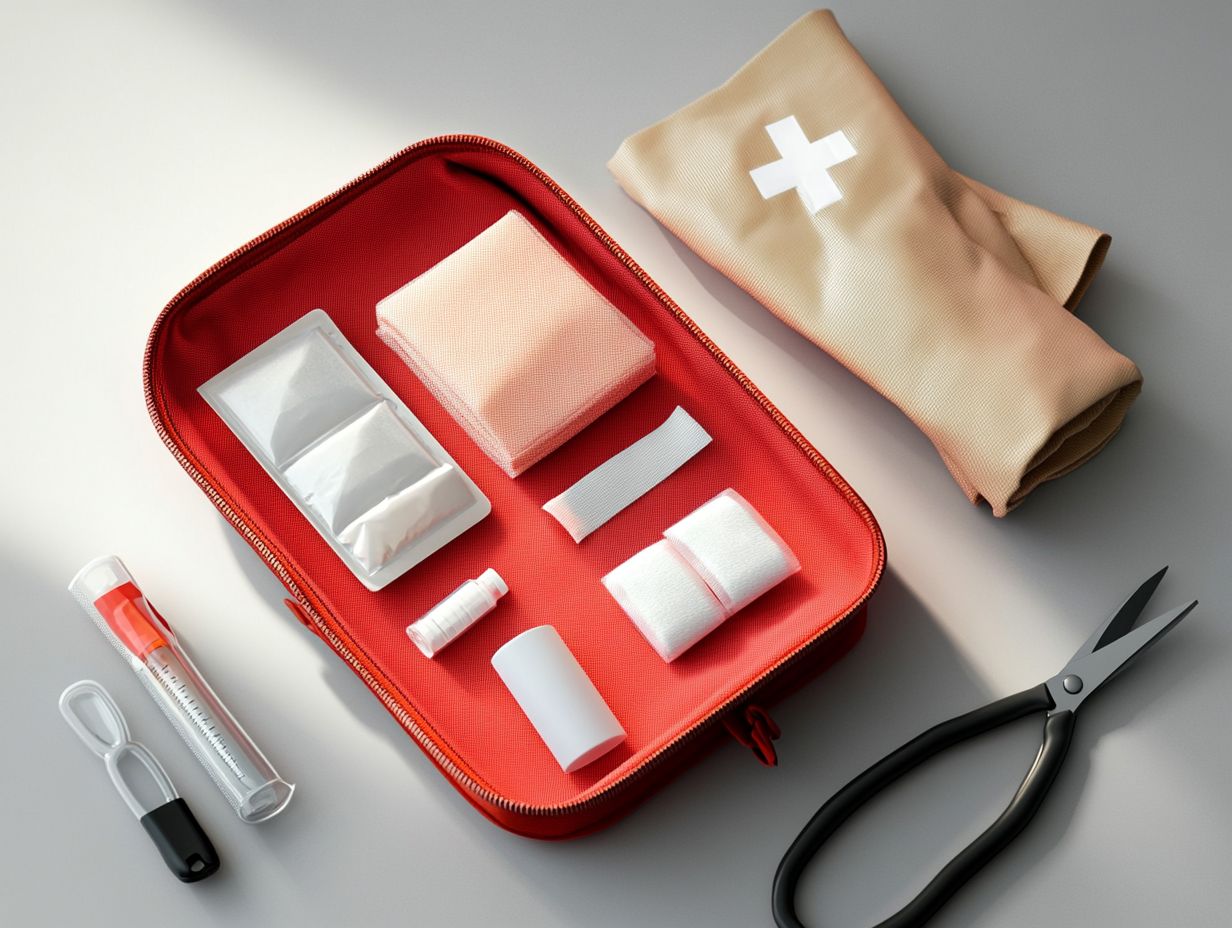
Including emergency contact information in your first-aid kit is absolutely essential for swift access during medical emergencies. This ensures that first responders can easily connect with your support network when it matters most.
Your emergency contact list should feature family members, close friends, and other trusted individuals who are well-acquainted with your medical history and can make crucial decisions on your behalf. It s wise to have multiple contacts listed to ensure someone is always available, especially in critical situations where immediate assistance is vital.
This level of preparedness not only boosts the likelihood of receiving timely help but also offers peace of mind, knowing that your loved ones can be promptly alerted and kept informed about your condition.
Take action today and prepare your emergency contact list. It could make all the difference!
Frequently Asked Questions
What are the essential first aid items that should be included in a survival kit?
Essential items include bandages, gauze, adhesive tape, antiseptic wipes, pain relief medication, and a first aid manual.
Why is it important to have first aid items in a survival kit?
First aid items are important because they can help treat injuries and prevent infections, which can be life-saving in an emergency situation.
Can I add additional first aid items to my survival kit?
Yes, you can add additional first aid items to your survival kit according to your specific needs, such as medications for allergies or personal medications.
How often should I check and replace first aid items in my survival kit?
Check your survival kit’s first aid items every 6-12 months. Do this sooner if you ve used any items or if they ve expired.
Are there special considerations when choosing first aid items for a survival kit?
Yes! Think about the dangers in your area and any personal medical needs. Also, consider the size and weight of your kit.
Can I use my survival kit’s first aid items for everyday use?
You can use some items daily. Just remember to regularly check and restock your kit to keep it ready for emergencies.

